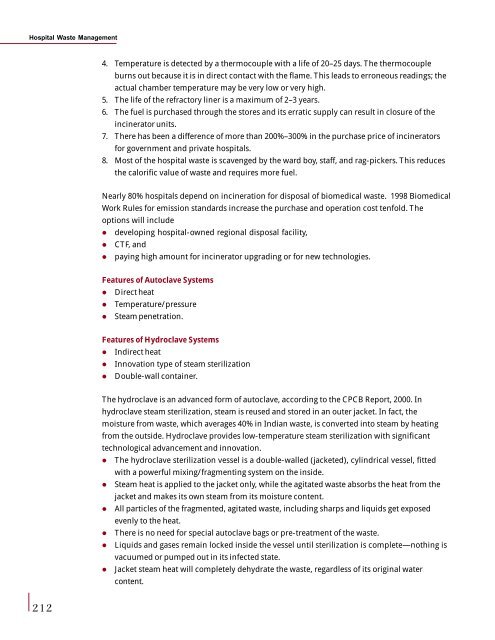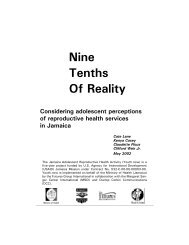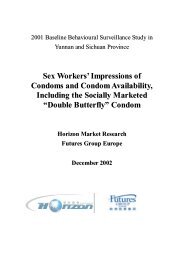Health Policy Issues and Health Programmes in ... - Amazon S3
Health Policy Issues and Health Programmes in ... - Amazon S3
Health Policy Issues and Health Programmes in ... - Amazon S3
- No tags were found...
You also want an ePaper? Increase the reach of your titles
YUMPU automatically turns print PDFs into web optimized ePapers that Google loves.
Hospital Waste Management4. Temperature is detected by a thermocouple with a life of 20–25 days. The thermocoupleburns out because it is <strong>in</strong> direct contact with the flame. This leads to erroneous read<strong>in</strong>gs; theactual chamber temperature may be very low or very high.5. The life of the refractory l<strong>in</strong>er is a maximum of 2–3 years.6. The fuel is purchased through the stores <strong>and</strong> its erratic supply can result <strong>in</strong> closure of the<strong>in</strong>c<strong>in</strong>erator units.7. There has been a difference of more than 200%–300% <strong>in</strong> the purchase price of <strong>in</strong>c<strong>in</strong>eratorsfor government <strong>and</strong> private hospitals.8. Most of the hospital waste is scavenged by the ward boy, staff, <strong>and</strong> rag-pickers. This reducesthe calorific value of waste <strong>and</strong> requires more fuel.Nearly 80% hospitals depend on <strong>in</strong>c<strong>in</strong>eration for disposal of biomedical waste. 1998 BiomedicalWork Rules for emission st<strong>and</strong>ards <strong>in</strong>crease the purchase <strong>and</strong> operation cost tenfold. Theoptions will <strong>in</strong>cludel develop<strong>in</strong>g hospital-owned regional disposal facility,l CTF, <strong>and</strong>l pay<strong>in</strong>g high amount for <strong>in</strong>c<strong>in</strong>erator upgrad<strong>in</strong>g or for new technologies.Features of Autoclave Systemsl Direct heatl Temperature/pressurel Steam penetration.Features of Hydroclave Systemsl Indirect heatl Innovation type of steam sterilizationl Double-wall conta<strong>in</strong>er.The hydroclave is an advanced form of autoclave, accord<strong>in</strong>g to the CPCB Report, 2000. Inhydroclave steam sterilization, steam is reused <strong>and</strong> stored <strong>in</strong> an outer jacket. In fact, themoisture from waste, which averages 40% <strong>in</strong> Indian waste, is converted <strong>in</strong>to steam by heat<strong>in</strong>gfrom the outside. Hydroclave provides low-temperature steam sterilization with significanttechnological advancement <strong>and</strong> <strong>in</strong>novation.l The hydroclave sterilization vessel is a double-walled (jacketed), cyl<strong>in</strong>drical vessel, fittedwith a powerful mix<strong>in</strong>g/fragment<strong>in</strong>g system on the <strong>in</strong>side.l Steam heat is applied to the jacket only, while the agitated waste absorbs the heat from thejacket <strong>and</strong> makes its own steam from its moisture content.l All particles of the fragmented, agitated waste, <strong>in</strong>clud<strong>in</strong>g sharps <strong>and</strong> liquids get exposedevenly to the heat.l There is no need for special autoclave bags or pre-treatment of the waste.l Liquids <strong>and</strong> gases rema<strong>in</strong> locked <strong>in</strong>side the vessel until sterilization is complete—noth<strong>in</strong>g isvacuumed or pumped out <strong>in</strong> its <strong>in</strong>fected state.l Jacket steam heat will completely dehydrate the waste, regardless of its orig<strong>in</strong>al watercontent.212







